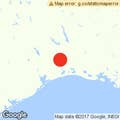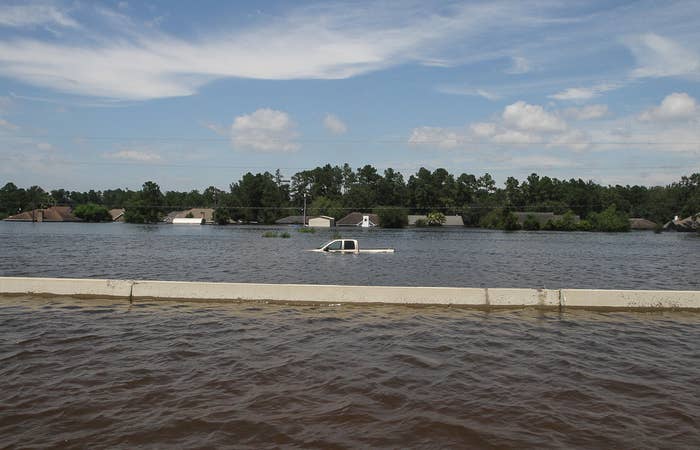
VIDOR, Texas — Just after 1 p.m. on Thursday, a convoy of pickup trucks and SUVs approached a blockade on I-10, just west of Orange, Texas. After conferring with the state patrol manning it, Lieutenant Tom Hebert pulled the convoy down the exit ramp for an impromptu meeting.
“You come at your own risk,” Hebert said.
Conditions on I-10 had deteriorated over the course of the morning, and long stretches of its westbound lanes were now deep lakes. The only way to get to Beaumont, where Acadian ambulance drivers were waiting to be resupplied, was down the eastbound side.
But traffic would be coming at them, Hebert said, and although concrete barricades were holding back the floodwaters for now, they could break at any moment, releasing a 3-foot-high wall of water into the line of relief vehicles. Although he’d help try to keep traffic away, he couldn’t guarantee anyone’s safety.
Heads nodded solemnly all around, and within minutes, the convoy was rolling directly into oncoming traffic.
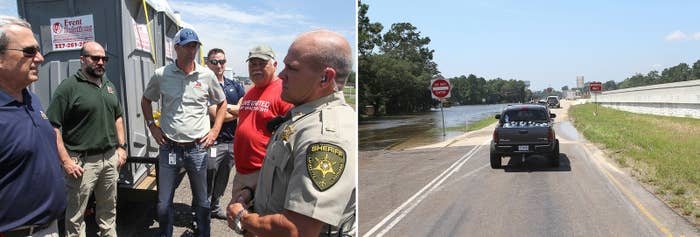
For the army of flood rescuers that have descended on East Texas in the wake of Hurricane Harvey, plenty of work remains. Although most rescue operations have halted in Orange, which on Wednesday had become a focal point of volunteer efforts, constant pleas for help from small towns along the I-10 corridor between Orange and Beaumont were still coming in to dispatchers for the volunteer Cajun Navy.
A young woman was stranded with three others in 3 feet of water in West Orange. An elderly man with emphysema had run out of medicine and was in dire condition in Mauriceville. Thirty people were stuck on a roof in Vidor.
The problem was getting there. Between Orange and Beaumont, the surface roads were almost entirely impassable, turning the rural enclaves into literal islands in a sea of fast-moving, polluted waters.
Although the rains had ended late Wednesday evening, runoff from the north was combining with releases from dams across the region to keep water levels rising, flooding communities already crippled by the storm and shutting down I-10’s westbound lanes.
And travel on the eastbound side was treacherous. Long lines of cars began streaming east Thursday afternoon after Beaumont officials began closing shelters there due to a lack of water and power, making nearby Lake Charles, Louisiana, the only safe place storm victims could be brought.
For miles, the Acadian convoy and other rescue workers made their way down the shoulder, past abandoned cars roof-deep in water and desolate stretches of country road that had become turbulent creeks and streams.
The way was slow going, with 3-foot-high floodwaters on one side and massive troop vehicles filled with evacuees zipping past on the other. Cracks were forming all along the unintentional dam and jets of floodwater were pouring out. Long sections of the eastbound lanes were under 2 feet of water, slowing progress significantly.
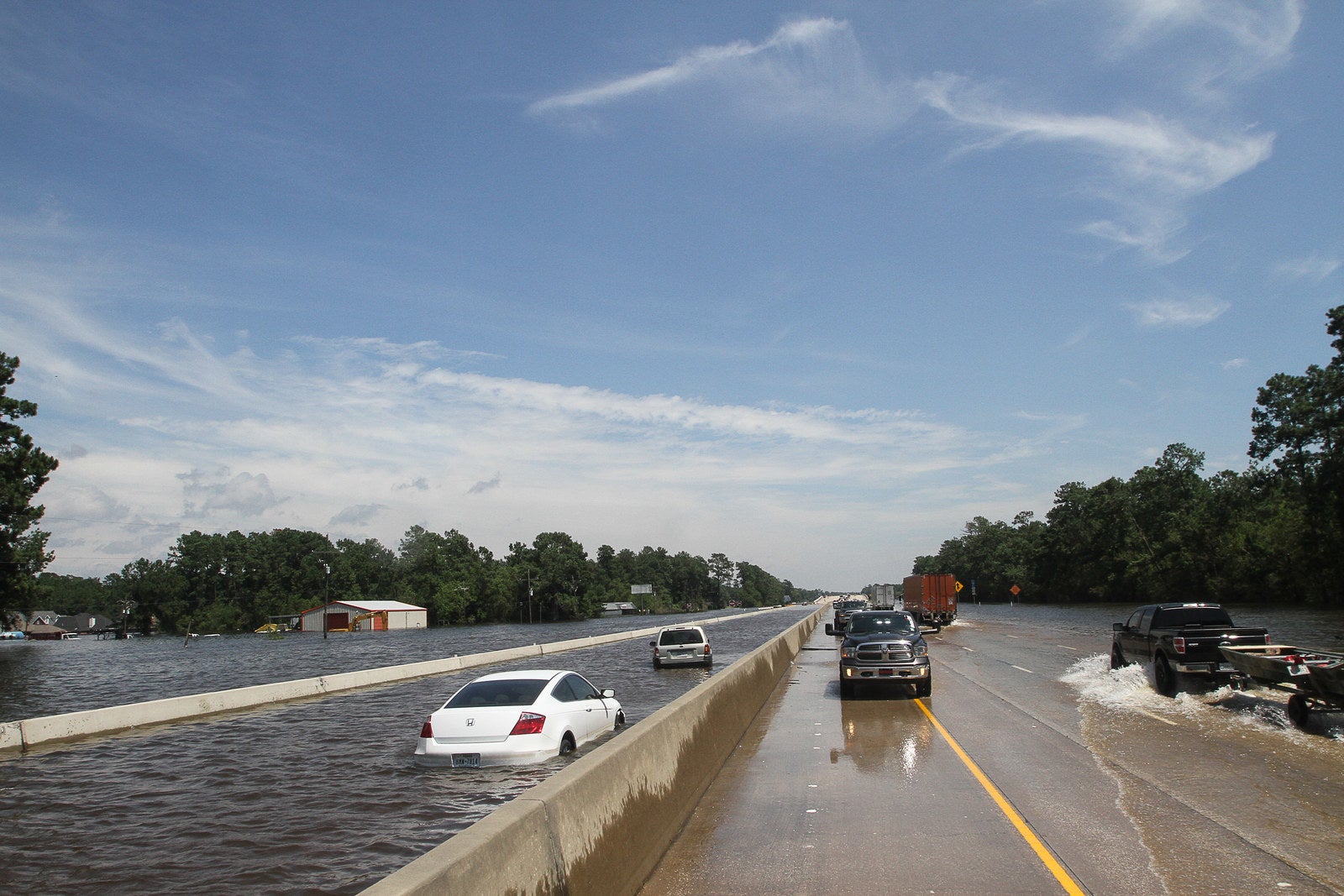
As the convoy approached the exit for Vidor, a small town 20 miles west of Orange, Hebert once again brought it to a halt. A young man in an Acadian uniform standing on the shoulder picked his way through traffic to the convoy as Hebert and the other drivers huddled under the intense Texas sun.
Standing with the members of the convoy, Zack Wright explained the situation. The barricades west of Vidor had broke, he said, sending a torrent of water south across the entire highway. Vidor was completely walled in to the west by water now, and there was no longer a way to get the supplies to Beaumont.
Wright, 35, had been stuck in Vidor for two days, watching as the water had risen, forcing his family to evacuate.
“This is the third spot we’ve evacuated to. Each time it’s risen. My house has water up to the roof,” Wright said.
It was the end of the line for the convoy, and the decision was quickly made to turn it around. Hebert was worried that the barricades the group had passed on the way in would buckle, leaving them stranded, potentially for days.
While the company would arrange for Wright to be airlifted to Beaumont later that day, the men unloaded 24 cases of drinking water they were carrying into a Vidor city worker’s pickup. Although some places in town still had running water, none of it was drinkable and supplies were running low.
As he was getting ready to head east, Hebert was asked what he thought of the situation. The barrel-chested sheriff paused.
“In 28 years, I’ve seen it a couple of times,” he said with a wry laugh. “We just went through it last year in Lafayette with the floods. Around here it’s always, a flood, or a hurricane, or some kind of natural disaster.”
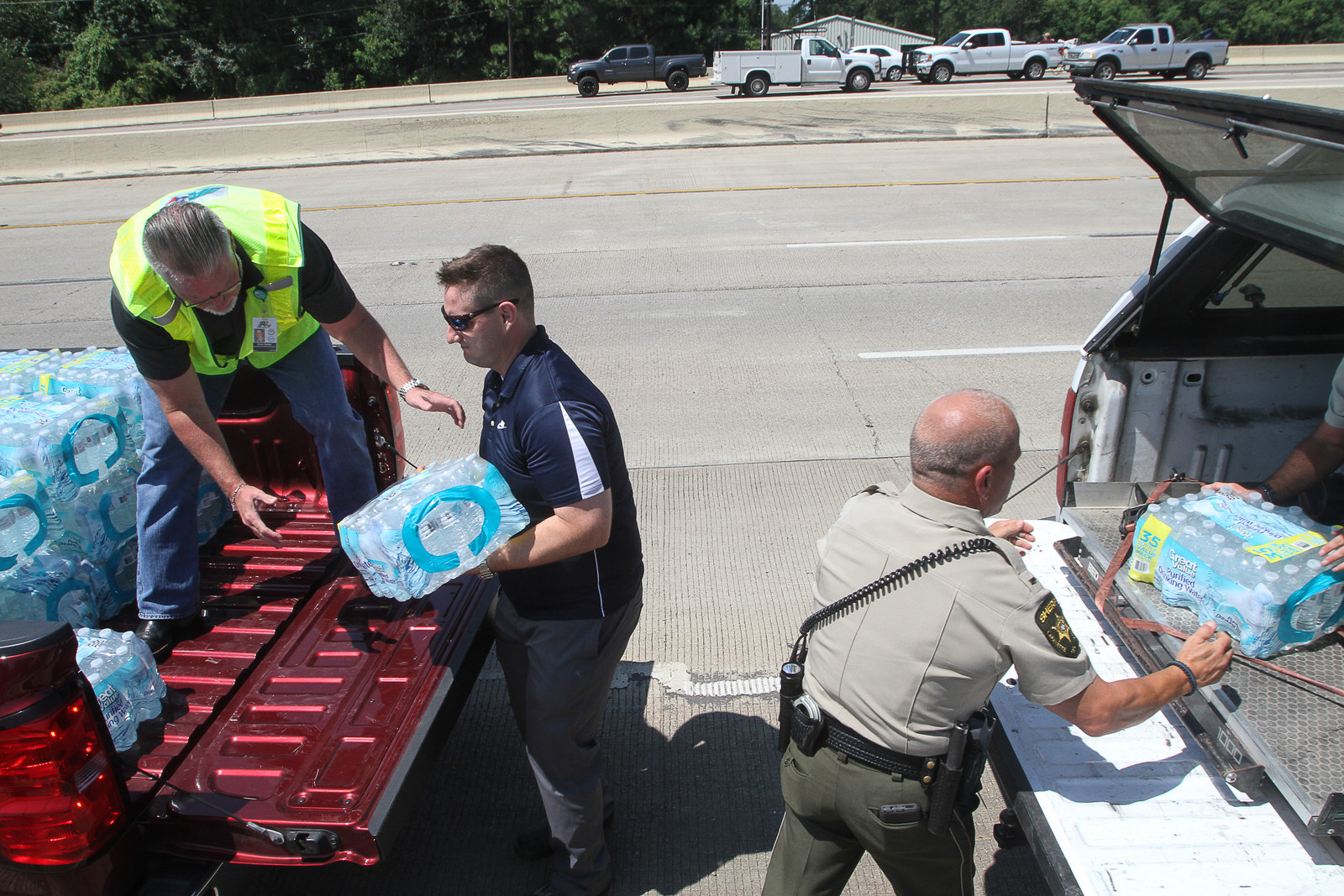
If Orange was the epicenter of volunteer work in east Texas Wednesday, by Thursday those efforts had shifted to smaller towns like Vidor, where dozens of trucks and boats were navigating deeply flooded streets in search of survivors. Although many were using the Cajun Navy’s dispatch system, many others weren’t, meaning rescuers had to be on the constant look out for people on the roofs of their houses and cars.
When state Department of Public Safety Sgt. John Henke arrived in Vidor, things were getting worse. Water levels weren’t going down, and without power, water, or gas, the few shelters in Vidor that were still open didn’t have the resources to take care of victims.
Henke, who’d spent the past two days in Kady, Texas, rescuing people in chest deep water, got into Vidor in midafternoon. He’d been tasked with organizing the evacuation of as many people as possible from the town, as soon as possible.
“They said get over there and set up an evacuation,” Henke said, motioning toward the knot of relief workers, national guardsmen, and state and local police who were busy at work in a mall parking lot feeding evacuees and preparing them for transport on school buses, troop carriers, and even dump trucks.
Vidor was no longer safe, and it was time to go.
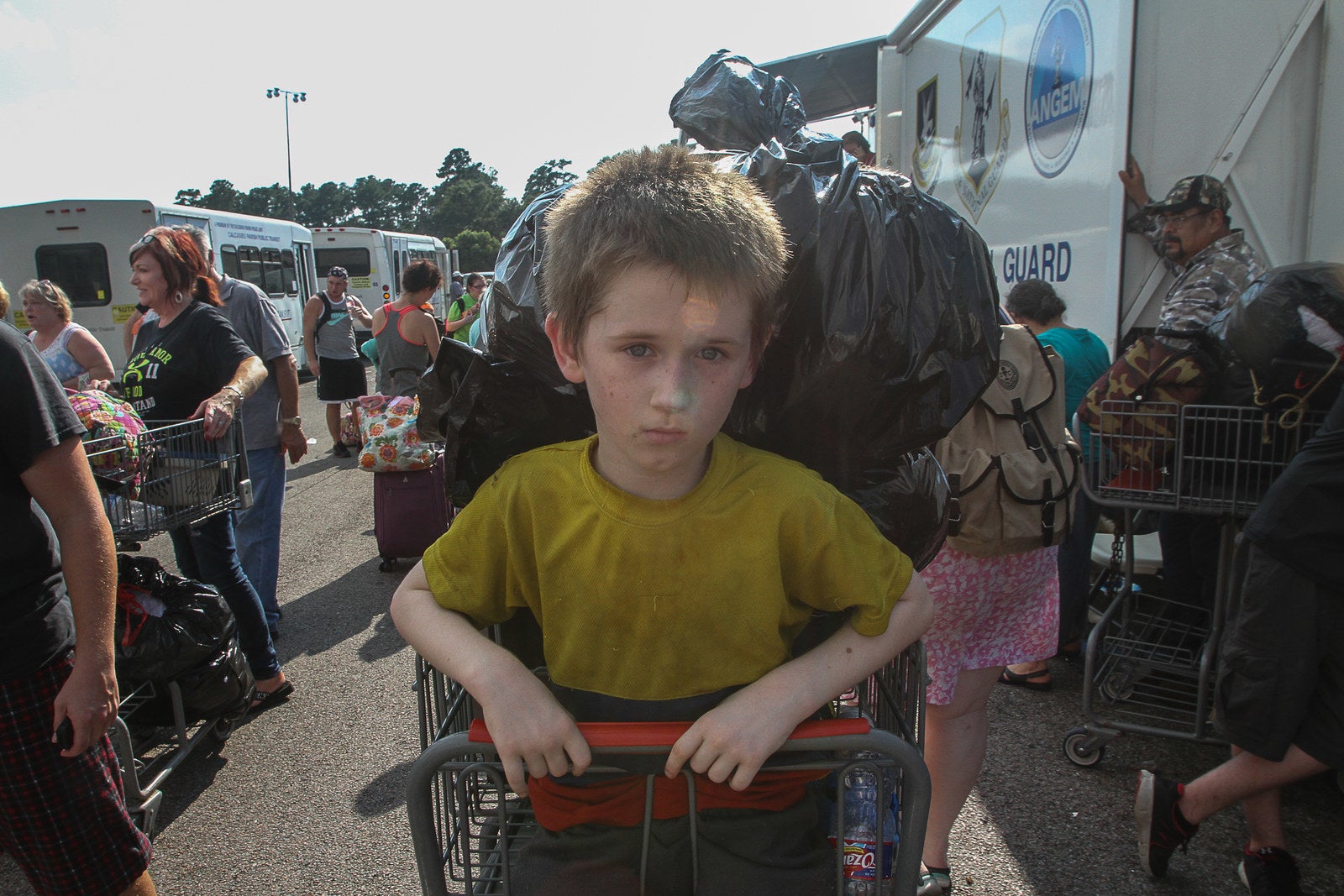
Although the full extent of the impacts of the storm won’t be known for months or years, in some places it was already obvious they will be profound. In Orange, floodwaters were already receding, laying bare the challenges of recovery.
Power was still out throughout much of the city, due in part to dozens of downed trees along Orange’s main drag, 16th Street. Crews of neighbors were busy cutting the huge trunks into manageable sizes and dragging them free of the wires.
In the parking lot of the Market Basket — which 24 hours before had sheltered hundreds of soaked evacuees — volunteers were bringing pallets of drinking water bottles that ran out almost immediately.
It was clear from the dazed looked in the eyes of residents who’d stayed on through the floods that while the rescue process may have only taken less than 48 hours, recovery would take much longer.
But in Vidor, Harvey’s attack was still happening.
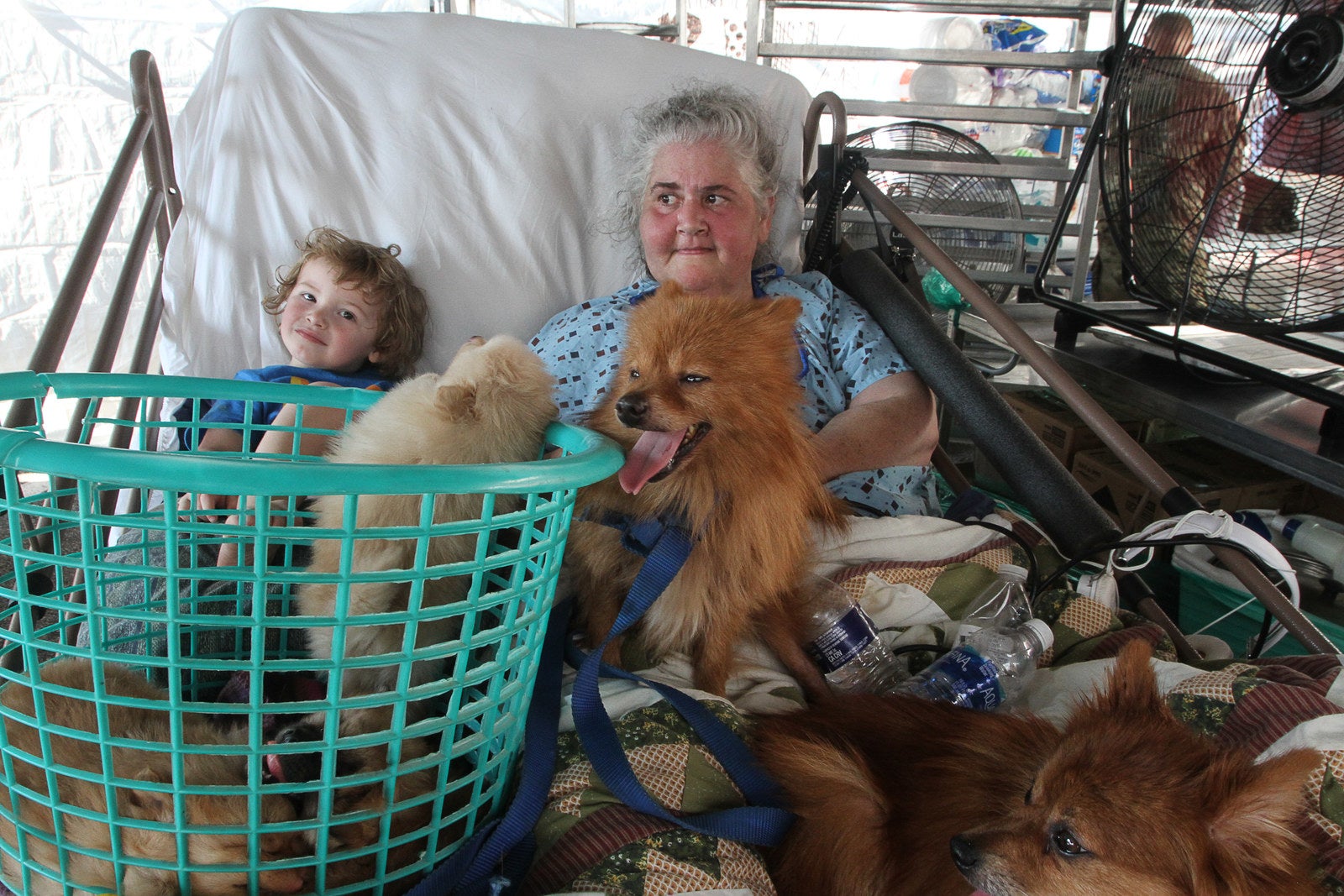
Nicky Coleman sat in a bit of shade behind the Air National Guard’s trailer awaiting transport to Lake Charles. A resident of Beaumont, Coleman had tried to leave there when conditions got bad, only to get stuck in his SUV as the floodwaters rushed into Vidor.
Holding his knees close to his chest, Coleman had the look of a fighter who still hadn’t quite realized they’d been knocked out.
“I was deep in the water, but I just kept on going,” he said. “I thought I was gonna get on dry land. But I got stuck.”
Asked about the storm, Coleman was quick to answer.
“Worse than Katrina,” he said. “Oh yeah, definitely.”
While it may not have fully hit many of the residents of East Texas, the weight of the devastation is definitely on the minds of people like Henke.
“This, it just breaks my heart. The devastation that happening here is just unfathomable,” Henke said, his voice cracking slightly.
Though he praised the work of volunteers and state and federal officials, having worked during hurricanes Katrina, Rita, and Ike, he was clearly worried about the lasting effects the storm will have.
“Harvey is by far the worst one I’ve seen,” he said.
If you've been impacted by the storm in Texas or have a tip about rescue, relief, government, or aid efforts, call the BuzzFeed News tipline at (646) 589-8598. Find us on Signal, email, SecureDrop, and more here.

